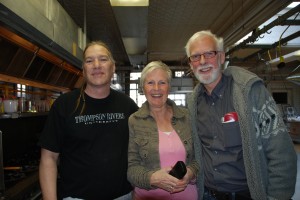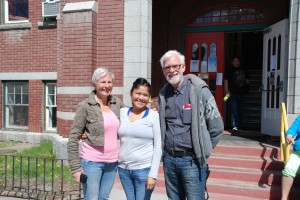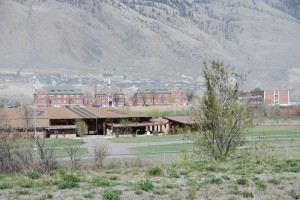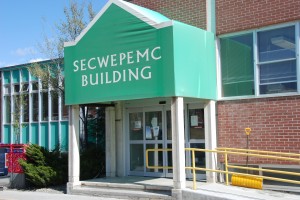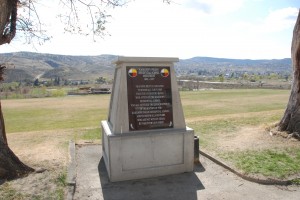In an earlier post I reported about my visit to the former Indian Residential School in Kamloops, British Columbia, Canada in April 2012. It told that the premises is now being used by first nations (‘Indians’ as they were called in the Western ‘culture’) for various purposes.
As said, this school, and other residential schools, for aboriginal children were a tragedy for the first nations culture. Children were taken from their families and put together in the residential schools were they had to assimilate in the Canadian (read: Western Christian) culture. Residential schools were created at the end of the 19th century and existed until the 1980s. I also said that currently, various first nations people are actively working on retaining their cultures and are negotiating terms for self-determination, land rights and natural resource ownership. It is a harsh struggle that cannot be missed when visiting beautiful British Columbia.
At that time I did not have much time to elaborate on the visit, but as these days at the beginning of 2013 are a bit more quiet, and as a result of an article in the National Geographic about the future of America’s first inhabitants, I went back to the visit, which happened after travels through Vancouver Island and the Rocky Mountains. On Vancouver Island various places are also reminders of the first nations cultures, such as in Alert Bay (Kwak’wala), with its U’mista Cultural Centre (with museum), big house and the highest totem pole in the world, and of course Victoria with its Royal British Columbia Museum, with an impressive collection of aboriginal history.
The story in the National Geographic is basically about the Sioux who live in South-Dakota, Nebraska, Wyoming, Montana and North-Dakota. During the 18th century they lost most of their land. The Supreme Court of the USA decided in 1980 that the federal government had to pay back 1 billion US Dollars. However, the Sioux do not accept this: they want to get their land back.
This story is much like what I heard and was in West-Canada. Property was lost, culture was practically demolished. To establish the latter, the residential schools were created. As said, children from first national peoples were forced to go to these schools, and lead a life which was totally unknown to the parents and their children. The Secwepemc museum tells the story of the residential school system and the residential school in Kamloops. Storyboards and pictures explain what happened. In the 19th century Europeans and Christianity got in contact with the Secwepemc region and people had to adjust to the systems of the Western standards. This had a deep impact on the cultural, social, economic, political and educational life. Regarding education, the Secwepemc educated children in its oral tradition. Learning was based on ‘… watching, listening and participating in community life’. All members of the community acted as teachers and learning activities were integrated in daily life. During the 1850s and 1860s Secwepemc children were ‘… forced into European education institutions’. Chiefs had to comply with conditions of the intruders and did so hoping they would save their peoples, land and culture. But they were betrayed, as the intention of the authorities was to let the first national peoples convert into Western ‘civilization’.
The first schools were called industrial schools, and they were opened during the second half of the 19th century. These schools operated as boarding schools, and prepared students for trades or ‘industries’. This went along with massive exploitation of child labor. Half of the day students had to work hard, and the other half day they spent on religious and basic academic education. I do not know exactly on what scale this industrial education took place and how it further developed, but if this kind of education was the forerunner of vocational education, it is no wonder that that type of education had a bad press in Northern-America. Students did hardly get any education in academic subjects, which was the core of liberal education in later periods of American history. The schools are created by the Canadian government in cooperation with Catholic, Methodists and Anglican churches. Oblates (members of congregations) have had an important influence on the creation of the industrial and boarding schools. They created St. Louis Mission near Kamloops. ‘The Oblates were not trained as teachers. Instead, their role in education came as an extension of their mission work aimed to consolidate a strong Catholic grip on First National communities’.
Life for students in the residential schools was very hard. Discipline was harsh, no contact with parents for extended periods of time was allowed, but school did also hardly have any resources. Complaints about educational practices were rejected or ignored as ‘Federal government policy dictated that First Nations parents were ignorant and incompetent’.
Speaking with First Nations representatives (while going around and being kindly invited for an indigenous lunch, which – surprise – was cooked by a First Nation cook who could speak Dutch because he was adopted by immigrants from the Netherlands) I did not only learn about some personal histories of those who endured the system when they were young, but also about the fact that a German scholar (whose name I do not know) visited the former Residential School to compare the history of the First Nations with the genocide during the Second World War. While I found this comparison somewhat radical, there are of course similarities between what has happened to Indians in the Americas and Jews and other groups in Europe caused by the feeling of superiority and hegemony of certain populations.
I think I was triggered by what I learned during my visit to Canada as there is still so much injustice and exclusive thinking in the world that needs to be overcome. Peace is needed, respect and cooperation. Those values also have to be taught in education, worldwide. That will make the world a better and more sustainable place. I sincerely hope that this will become more possible in these times of universal transformation.

